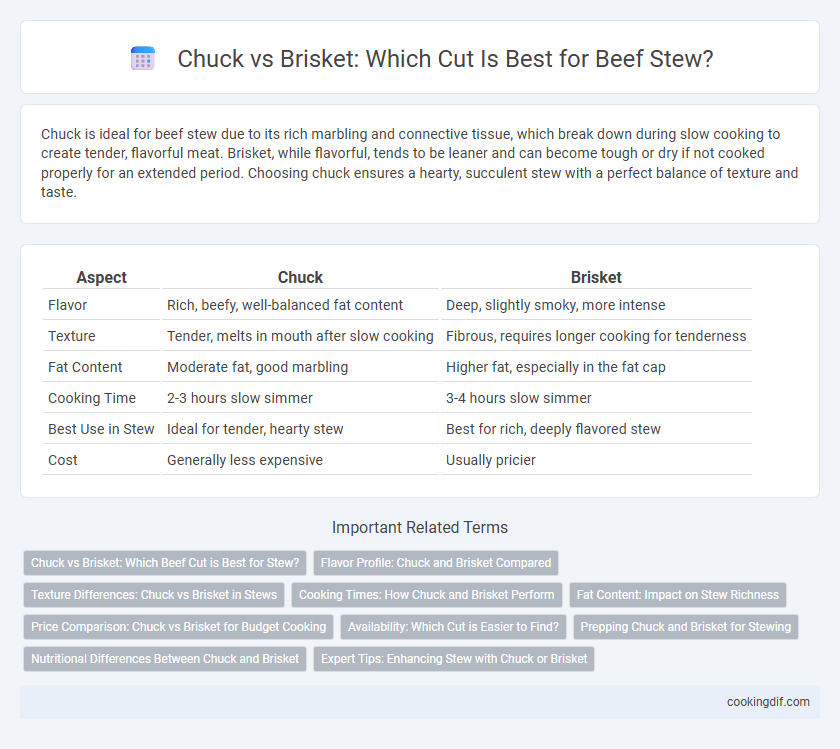Chuck is ideal for beef stew due to its rich marbling and connective tissue, which break down during slow cooking to create tender, flavorful meat. Brisket, while flavorful, tends to be leaner and can become tough or dry if not cooked properly for an extended period. Choosing chuck ensures a hearty, succulent stew with a perfect balance of texture and taste.
Table of Comparison
| Aspect | Chuck | Brisket |
|---|---|---|
| Flavor | Rich, beefy, well-balanced fat content | Deep, slightly smoky, more intense |
| Texture | Tender, melts in mouth after slow cooking | Fibrous, requires longer cooking for tenderness |
| Fat Content | Moderate fat, good marbling | Higher fat, especially in the fat cap |
| Cooking Time | 2-3 hours slow simmer | 3-4 hours slow simmer |
| Best Use in Stew | Ideal for tender, hearty stew | Best for rich, deeply flavored stew |
| Cost | Generally less expensive | Usually pricier |
Chuck vs Brisket: Which Beef Cut is Best for Stew?
Chuck is the preferred beef cut for stew due to its higher fat content and marbling, which breaks down into tender, flavorful meat during slow cooking. Brisket is leaner and can become tough unless cooked very slowly at low temperatures, but it offers a richer, beefier flavor. For the best stew results, chuck balances tenderness and taste, making it more suitable than brisket.
Flavor Profile: Chuck and Brisket Compared
Chuck offers a rich, beefy flavor with moderate marbling that breaks down into tender, succulent bites perfect for stew. Brisket has a deeper, more intense beef taste with a slightly smoky undertone resulting from its dense muscle fibers and higher fat content. Choosing between chuck and brisket for beef stew depends on whether a milder savory richness or a robust, hearty flavor is preferred.
Texture Differences: Chuck vs Brisket in Stews
Chuck offers a tender, well-marbled texture that breaks down into juicy, succulent pieces during slow cooking, making it ideal for rich, hearty beef stews. Brisket features a coarser grain and firmer texture, resulting in a chewier bite that holds shape well but requires longer simmering to become tender. Choosing chuck yields a more melt-in-the-mouth stew, while brisket provides a meatier, slightly fibrous consistency that adds variety to the stew's texture.
Cooking Times: How Chuck and Brisket Perform
Chuck beef typically cooks faster than brisket in stew recipes, becoming tender within 2 to 3 hours of simmering due to its higher fat content and marbling. Brisket requires a longer cooking time, often 3 to 4 hours or more, as its dense muscle fibers need extended heat to break down and achieve a tender texture. Choosing chuck can reduce stew preparation time, while brisket offers a richer, more gelatinous mouthfeel with slow cooking.
Fat Content: Impact on Stew Richness
Chuck beef contains a higher fat content than brisket, making it ideal for rich, flavorful stews due to its marbling that melts into the broth. The moderate fat in chuck enhances the stew's mouthfeel and depth, creating a hearty texture. Brisket, being leaner, results in a lighter stew with less unctuousness but still provides a tender, beefy taste when slow-cooked.
Price Comparison: Chuck vs Brisket for Budget Cooking
Chuck is generally more affordable than brisket, making it a popular choice for budget-conscious beef stew recipes. While brisket offers a richer flavor and tender texture, its higher price per pound can be a limiting factor for cost-saving meal planning. Choosing chuck allows for a hearty, flavorful stew without significantly impacting the grocery budget.
Availability: Which Cut is Easier to Find?
Chuck is generally easier to find in most grocery stores and supermarkets compared to brisket, as it is a more common cut used for stews and braising. Brisket tends to be more popular for smoking and barbecue, which can limit its availability in smaller or less specialized markets. Therefore, for convenience and accessibility, chuck is the preferred choice for beef stew.
Prepping Chuck and Brisket for Stewing
Chuck and brisket are both excellent choices for beef stew, but prepping methods differ to maximize tenderness and flavor. Chuck requires trimming excess fat and cutting into uniform cubes to ensure even cooking, while brisket benefits from slow marinating and removing the thick silver skin to prevent toughness. Both cuts should be browned thoroughly before stewing to develop rich, caramelized flavors essential for a hearty stew.
Nutritional Differences Between Chuck and Brisket
Chuck and brisket differ notably in nutritional content, impacting their suitability for beef stew. Chuck contains approximately 280 calories and 18 grams of fat per 3-ounce cooked serving, offering a richer flavor and higher iron content. Brisket typically has around 220 calories and 13 grams of fat per 3-ounce cooked portion, providing leaner protein with slightly less fat but similar levels of zinc and vitamin B12.
Expert Tips: Enhancing Stew with Chuck or Brisket
Chuck offers rich marbling that melts into tender, flavorful beef stew, making it a top choice for slow cooking. Brisket provides a slightly fattier, denser texture that breaks down into silky, succulent bites when simmered long enough. Expert tips recommend browning chuck for deep flavor and using brisket when a richer, melt-in-your-mouth consistency is desired in hearty stew recipes.
Chuck vs brisket for beef stew Infographic

 cookingdif.com
cookingdif.com